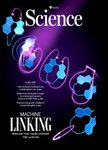-
作者:Yin, Max Dongsheng; Lemaire, Olivier N.; Jimenez, Jose Guadalupe Rosas; Belhamri, Melissa; Shevchenko, Anna; Hummer, Gerhard; Wagner, Tristan; Murphy, Bonnie J.
作者单位:Max Planck Society; Max Planck Society; Max Planck Society; Max Planck Society; Communaute Universite Grenoble Alpes; Universite Grenoble Alpes (UGA); CEA; Centre National de la Recherche Scientifique (CNRS)
摘要:In the ancient microbial Wood-Ljungdahl pathway, carbon dioxide (CO2) is fixed in a multistep process that ends with acetyl-coenzyme A (acetyl-CoA) synthesis at the bifunctional carbon monoxide dehydrogenase/acetyl-CoA synthase complex (CODH/ACS). In this work, we present structural snapshots of the CODH/ACS from the gas-converting acetogen Clostridium autoethanogenum, characterizing the molecular choreography of the overall reaction, including electron transfer to the CODH for CO2 reduction, ...
-
作者:Chandrashekhar, Vaishnavi
摘要:Surprise finding of few health payoffs complicates push to replace biomass fuel
-
作者:Pennisi, Elizabeth
摘要:Even in some common species, the genetic variation key to resilience is slipping away
-
作者:[Anonymous]
摘要:Breakdown in collaboration leads many scientists to look to domestic projects-and to China
-
作者:Rousset, Francois; Osterman, Ilya; Scherf, Tali; Falkovich, Alla H.; Leavitt, Azita; Amitai, Gil; Shir, Sapir; Malitsky, Sergey; Itkin, Maxim; Savidor, Alon; Sorek, Rotem
作者单位:Weizmann Institute of Science; Weizmann Institute of Science; Weizmann Institute of Science; Weizmann Institute of Science; Institut National de la Sante et de la Recherche Medicale (Inserm); Universite Claude Bernard Lyon 1; Centre National de la Recherche Scientifique (CNRS); CNRS - National Institute for Biology (INSB); Ecole Normale Superieure de Lyon (ENS de LYON)
摘要:Caspase family proteases and Toll/interleukin-1 receptor (TIR)-domain proteins have central roles in innate immunity and regulated cell death in humans. We describe a bacterial immune system comprising both a caspase-like protease and a TIR-domain protein. We found that the TIR protein, once it recognizes phage invasion, produces the previously unknown immune signaling molecule adenosine 5-diphosphate-cyclo[N7:1 '']-ribose (N7-cADPR). This molecule specifically activates the bacterial caspase-...
-
作者:Ugras, Thomas J.; Carson, River B.; Lynch, Reilly P.; Li, Haoyang; Yao, Yuan; Cupellini, Lorenzo; Page, Kirt A.; Wang, Da; Arbe, Arantxa; Bals, Sara; Smieska, Louisa; Woll, Arthur R.; Arteaga, Oriol; Javorfi, Tamas; Siligardi, Giuliano; Pescitelli, Gennaro; Weinstein, Steven J.; Robinson, Richard D.
作者单位:Cornell University; Cornell University; University of Pisa; Cornell University; University of Antwerp; University of Barcelona; Diamond Light Source; Rochester Institute of Technology; CIC biomaGUNE
摘要:Highly concentrated solutions of asymmetric semiconductor magic-sized clusters (MSCs) of cadmium sulfide, cadmium selenide, and cadmium telluride were directed through a controlled drying meniscus front, resulting in the formation of chiral MSC assemblies. This process aligned their transition dipole moments and produced chiroptic films with exceptionally strong circular dichroism. G-factors reached magnitudes as high as 1.30 for drop-cast films and 1.06 for patterned films, approaching theore...
-
作者:Brainard, Jeffery
-
作者:Sakakibara, Masaya; Hanaya, Minoru; Nakamuro, Takayuki; Nakamura, Eiichi
作者单位:University of Tokyo; Gunma University
摘要:Phase diagrams and crystallography are standard tools for studying structural phase transitions, whereas acquiring kinetic information at the atomistic level has been considered essential but challenging. The eta-to-theta phase transition of alumina is unidirectional in bulk and retains the crystal lattice orientation. We report a rare example of a statistical kinetics study showing that for nanoparticles on a bulk Al(OH)(3) surface, this phase transition occurs nondeterministically through an...
-
作者:Sills, Jennifer
-
作者:Mervis, Jeffrey
摘要:A small statistical agency within the U.S. Department of Agriculture was torn apart under Trump-and then rebuilt. What did it lose, and what can other U.S. research agencies learn from it?
